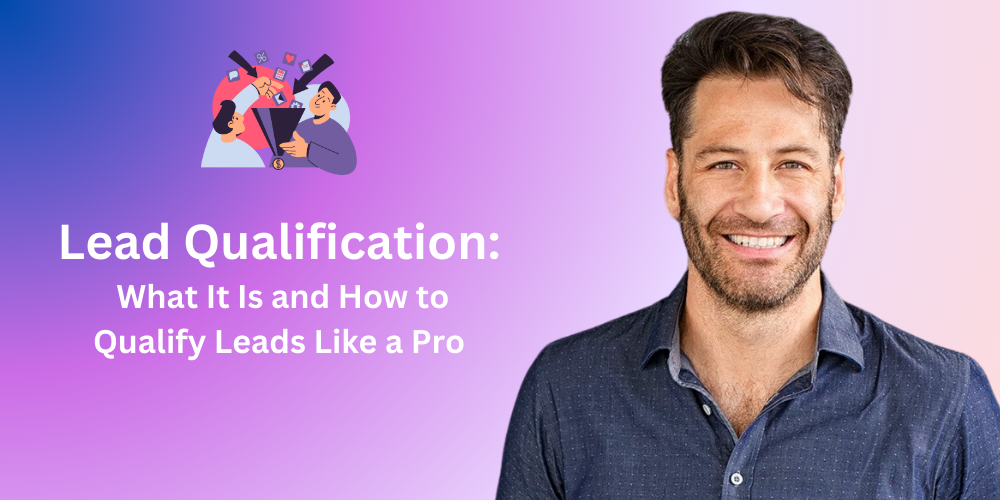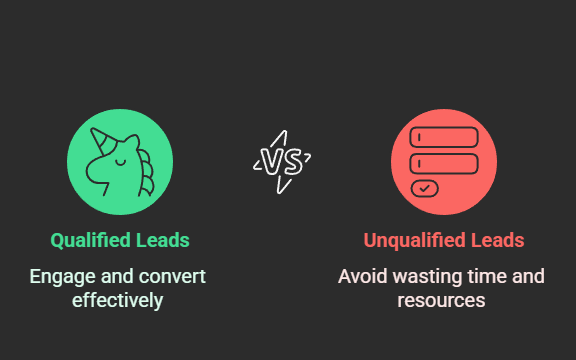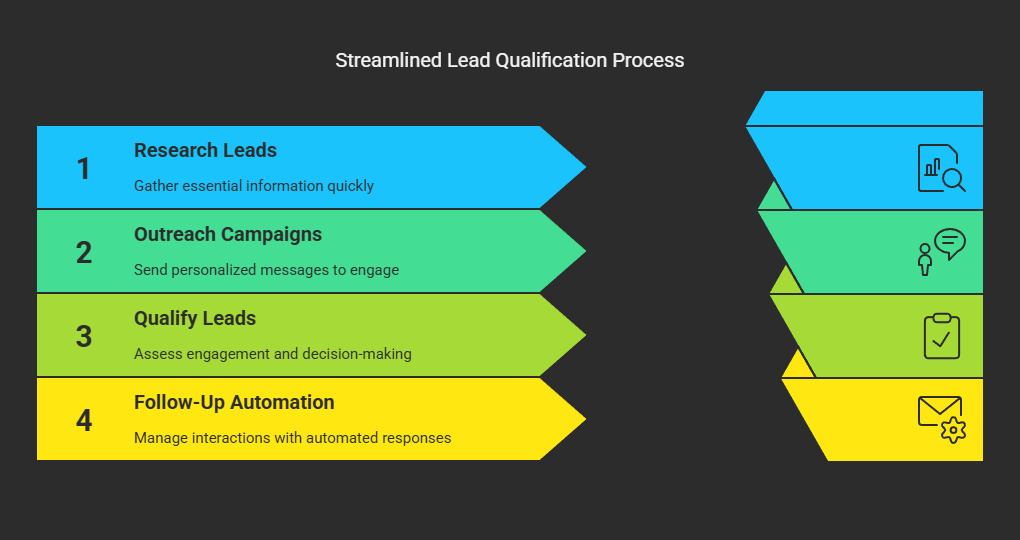Lead Qualification 101: What It Is and How to Qualify Leads Like a Pro

You’re excited about launching your B2B campaign. You’ve prepared your strategy, crafted great content, and you’re ready to watch leads roll in. But reality check—today’s B2B buyers are smart, informed, and picky. So how do you ensure you’re chasing the right prospects and not wasting your precious coffee-driven energy?
That's where lead qualification comes in. Let’s break it down without the fluff:
What Exactly Is Lead Qualification?

Lead qualification is simply deciding if a prospect is worth your time and effort. It’s about asking, “Is this someone who actually wants—and can buy—what I'm selling?” It helps you avoid pitching to people who’d rather watch paint dry than respond to your emails.
Why Lead Qualification Matters

Sales is time-consuming—lead qualification ensures you spend that time wisely. Instead of chasing every lead, you focus on the ones most likely to convert. Here’s why it’s worth the effort:
1. Keeps You Focused
No more shouting into the void. When you qualify your leads, you're only talking to people who actually want to hear from you. That means no more chasing ghosts or following up on prospects who treat your emails like spam.
2. Boosts Efficiency
Your time is valuable (and limited). When you know who’s ready to buy, you can prioritize the hot leads and skip the ones who are “just browsing.” The result? A calendar full of meaningful meetings, not dead-end check-ins.
3. Shortens Your Sales Cycle
Ever spent weeks emailing someone who never planned to buy in the first place? Yeah, us too. Qualification helps you skip the small talk and jump straight into real conversations with people who are ready to make moves.
4. Improves Your Win Rate
When you're pitching to the right people, your close rate naturally climbs. No more hoping for the best—you’re aiming at a target you can actually hit.
5. Saves Your Budget
Marketing dollars don’t grow on trees. Instead of blasting your budget on anyone with a pulse, you can invest in leads who are genuinely likely to convert—and stick around.
6. Better ROI
More qualified leads = more deals closed. It’s math, baby. And when your time, money, and effort go into people who matter, the return on investment speaks for itself.
Qualified vs. Unqualified Leads (Or "Real Prospects vs. Time Wasters")

Not all leads are created equal. Some are diamonds in the rough, others are just… rough. Knowing the difference between a real-deal buyer and a professional tire-kicker saves you a world of frustration. Here's how to tell who’s who:
Qualified Leads:
These are the unicorns. They’re engaged, they respond, they ask good questions, and—wait for it—they actually have the power (and budget) to make a purchase. You send them a meeting invite, and they actually show up. Wild, right?
Unqualified Leads:
You know the type. They seem interested, maybe even schedule a call, but then ghost harder than a bad Tinder date. They either don’t have the budget, the authority, or the actual interest to buy. Basically, they’re just window shopping—with your time.
How to Qualify Leads

Lead qualification doesn't have to be painful just follow a solid framework and ask the right questions.
Step 1: Get Your Framework Right
Before you can qualify leads effectively, you need a playbook—a framework to help you spot who’s worth your time and who’s just kicking tires. The classics still work, but there are also newer frameworks built for faster sales cycles, complex deals, and buyers who’ve done their homework. Here's a breakdown of the most popular ones:
- BANT (Budget, Authority, Need, Timeline): It’s been around forever because it works. The idea is simple: if your lead has the money, the decision-making power, a real need for your product, and a clear timeline to act, you’ve got yourself a qualified prospect. It’s especially useful in traditional B2B settings where budget plays a big role in the decision.
- ChAMP (Challenges, Authority, Money, Priorities): This framework flips the script a bit, putting Challenges front and center, followed by Authority, Money, and Priorities. It’s perfect for sales reps who like to lead with value and understand what’s driving their buyer before talking numbers.
- ANUM (Authority, Need, Urgency, Money): It gets right to the core: Who’s in charge? Do they need what you’re offering? Are they in a rush? Can they afford it? If you’re in a high-velocity sales environment where you need to qualify quickly, this one’s a strong choice.
- MEDDPICC (Metrics, Economic Buyer, Decision Maker, Developed Need, Paper Process, Identify Pain, Champion, Competition): In-depth framework, popular with SaaS sales teams. Think of it as the Avengers of qualification frameworks.
- GPCTBA/C&I (Goals, Plans, Challenges, Timeline, Budget, Authority, Consequences & Implications): It’s designed to uncover not just what your prospect wants—but why they want it, how they plan to get there, and what happens if they don’t. It’s great for sellers who need to map out the bigger picture before pitching a solution.
- MINDA (Money, Interest, Need, Decision Time, Authority): It’s super practical, especially for smaller deals or early lead scoring. Think of it as your go-to checklist when you need to make a quick judgment call on whether a lead is worth a deeper conversation.
Step 2: Create Your Lead Qualification Checklist
Quick, jot this down:
- Company size
- Industry
- Location
- Revenue & budget
- Decision maker’s title
- Timeline
- Current solutions
- Pain points (other than your Monday morning sales call)
How to Use LeadPlay.io for Smooth Lead Qualification

Instead of manually snooping through LinkedIn profiles, use LeadPlay to automate your sales efforts:
Step 1: Research (Without Stalking) LeadPlay pulls important info—like company details, contact info, and job titles—in seconds. No more late-night Googling and accidental liking of their family holiday posts from 2018.
Step 2: Outreach (Minus the Awkwardness) Craft cold outreach messages that don't feel like robotic spam. LeadPlay’s personalized drip campaigns on LinkedIn mean your messages sound human (and less likely to get blocked).
Step 3: Qualification (Make or Break) Track key indicators using built-in analytics. Here's what qualified leads look like:
- Regularly engage with your brand
- Clearly interested
- Have a budget
- Decision-maker identified
Unqualified leads?
- Ghost mode activated
- Vague budget and timelines
- Only interested in price battles
Luckily, LeadPlay automates polite follow-ups and gently waves goodbye to dead-end leads, so you don't have to.
Stop the Spray-and-Pray Approach
Good lead qualification is like using a GPS. Without it, you’re driving blindfolded, hoping you’ll stumble into sales. Use tools like LeadPlay.io, choose a solid qualification framework, and never again spend a Monday morning talking to someone who'd rather be anywhere else.